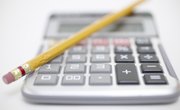
The sum and product rules of probability refer to methods of figuring out the probability of two events, given the probabilities of each event. The sum rule is for finding the probability of either of two events that cannot occur simultaneously. The product rule is for finding the probability of both of two events that are independent.
Explaining the Sum Rule
Write the sum rule and explain it in words. The sum rule is given by P(A + B) = P(A) + P(B). Explain that A and B are each events that could occur, but cannot occur at the same time.
Give examples of events that cannot occur simultaneously and show how the rule works. One example: The probability that the next person walking into class will be a student and the probability that the next person will be a teacher. If the probability of the person being a student is 0.8 and the probability of the person being a teacher is 0.1, then the probability of the person being either a teacher or student is 0.8 + 0.1 = 0.9.
Give examples of events that can occur at the same time, and show how the rule fails. One example: The probability that the next flip of a coin is heads or that the next person walking into the class is a student. If the probability of heads is 0.5 and the probability of the next person being a student is 0.8, then the sum is 0.5 + 0.8 = 1.3; but probabilities must all be between 0 and 1.
Product Rule
Write the rule and explain the meaning. The product rule is P( EF) = P(E)P(F) where E and F are events that are independent. Explain that independence means that one event occurring has no effect on the probability of the other event occurring.
Give examples of how the rule works when events are independent. One example: When picking cards from a deck of 52 cards, the probability of getting an ace is 4/52 = 1/13, because there are 4 aces among the 52 cards (this should have been explained in an earlier lesson). The probability of picking a heart is 13/52 = 1/4. The probability of picking the ace of hearts is 1/4*1/13 =1/52.
Give examples where the rule fails because the events are not independent. One example: The probability of picking an ace is 1/13, the probability of picking a two is also 1/13. But the probability of picking an ace and a two in the same card is not 1/13*1/13, it is 0, because the events are not independent.
References
About the Author
Peter Flom is a statistician and a learning-disabled adult. He has been writing for many years and has been published in many academic journals in fields such as psychology, drug addiction, epidemiology and others. He holds a Ph.D. in psychometrics from Fordham University.
